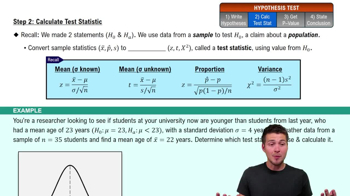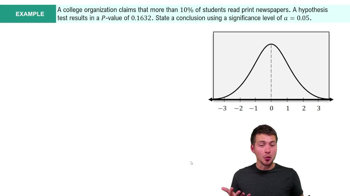Kruskal-Wallis Test What parametric test can also be conducted instead of the Kruskal-Wallis test? What is an advantage of using the Kruskal-Wallis test instead of the parametric test?
Table of contents
- 1. Intro to Stats and Collecting Data1h 14m
- 2. Describing Data with Tables and Graphs1h 55m
- 3. Describing Data Numerically2h 5m
- 4. Probability2h 16m
- 5. Binomial Distribution & Discrete Random Variables3h 6m
- 6. Normal Distribution and Continuous Random Variables2h 11m
- 7. Sampling Distributions & Confidence Intervals: Mean3h 23m
- Sampling Distribution of the Sample Mean and Central Limit Theorem19m
- Distribution of Sample Mean - Excel23m
- Introduction to Confidence Intervals15m
- Confidence Intervals for Population Mean1h 18m
- Determining the Minimum Sample Size Required12m
- Finding Probabilities and T Critical Values - Excel28m
- Confidence Intervals for Population Means - Excel25m
- 8. Sampling Distributions & Confidence Intervals: Proportion1h 12m
- 9. Hypothesis Testing for One Sample3h 29m
- 10. Hypothesis Testing for Two Samples4h 50m
- Two Proportions1h 13m
- Two Proportions Hypothesis Test - Excel28m
- Two Means - Unknown, Unequal Variance1h 3m
- Two Means - Unknown Variances Hypothesis Test - Excel12m
- Two Means - Unknown, Equal Variance15m
- Two Means - Unknown, Equal Variances Hypothesis Test - Excel9m
- Two Means - Known Variance12m
- Two Means - Sigma Known Hypothesis Test - Excel21m
- Two Means - Matched Pairs (Dependent Samples)42m
- Matched Pairs Hypothesis Test - Excel12m
- 11. Correlation1h 6m
- 12. Regression1h 50m
- 13. Chi-Square Tests & Goodness of Fit1h 57m
- 14. ANOVA1h 57m
9. Hypothesis Testing for One Sample
Steps in Hypothesis Testing
Problem 13.RE.5
Textbook Question
In Exercises 1–10, use a 0.05 significance level with the indicated test. If no particular test is specified, use the appropriate nonparametric test from this chapter.
World Series The last 114 baseball World Series ended with 66 wins by American League teams and 48 wins by National League teams. Use the sign test to test the claim that in each World Series, the American League team has a 0.5 probability of winning.
 Verified step by step guidance
Verified step by step guidance1
Step 1: Understand the problem. The claim is that the American League team has a 0.5 probability of winning each World Series. This is a binomial probability problem, and we will use the sign test to evaluate the claim at a 0.05 significance level.
Step 2: Define the null hypothesis (H₀) and the alternative hypothesis (H₁). H₀: The probability of the American League team winning is 0.5 (p = 0.5). H₁: The probability of the American League team winning is not 0.5 (p ≠ 0.5).
Step 3: Calculate the test statistic. The sign test compares the number of successes (American League wins) to the expected number under the null hypothesis. Here, the total number of World Series is 114, with 66 wins for the American League and 48 wins for the National League. The test statistic is based on the number of wins greater than or less than the expected value under H₀.
Step 4: Determine the critical value or p-value. Using the binomial distribution with n = 114 and p = 0.5, calculate the probability of observing 66 or more wins (or 48 or fewer wins, since this is a two-tailed test). Use statistical software, a binomial table, or an approximation (e.g., normal approximation) to find the p-value.
Step 5: Compare the p-value to the significance level (α = 0.05). If the p-value is less than 0.05, reject the null hypothesis (H₀). Otherwise, fail to reject H₀. Conclude whether there is sufficient evidence to support the claim that the American League team does not have a 0.5 probability of winning each World Series.
 Verified video answer for a similar problem:
Verified video answer for a similar problem:This video solution was recommended by our tutors as helpful for the problem above
Video duration:
3mPlay a video:
Was this helpful?
Key Concepts
Here are the essential concepts you must grasp in order to answer the question correctly.
Sign Test
The sign test is a nonparametric statistical method used to evaluate the median of a distribution. It is particularly useful when the data does not meet the assumptions required for parametric tests. In this context, it assesses whether the proportion of wins by American League teams differs from the expected probability of 0.5, indicating a fair chance of winning.
Recommended video:
Guided course

Step 2: Calculate Test Statistic
Null Hypothesis and Alternative Hypothesis
In hypothesis testing, the null hypothesis (H0) represents a statement of no effect or no difference, while the alternative hypothesis (H1) suggests a significant effect or difference. For this question, H0 would state that the probability of an American League team winning is 0.5, while H1 would claim that this probability is not equal to 0.5, guiding the analysis of the World Series outcomes.
Recommended video:
Guided course

Step 1: Write Hypotheses
Significance Level
The significance level, often denoted as alpha (α), is the threshold for determining whether to reject the null hypothesis. A significance level of 0.05 indicates a 5% risk of concluding that a difference exists when there is none. In this exercise, it sets the criteria for evaluating the results of the sign test, helping to decide if the observed wins by American League teams are statistically significant.
Recommended video:
Guided course

Step 4: State Conclusion Example 4

 6:21m
6:21mWatch next
Master Step 1: Write Hypotheses with a bite sized video explanation from Patrick
Start learningRelated Videos
Related Practice
Textbook Question
